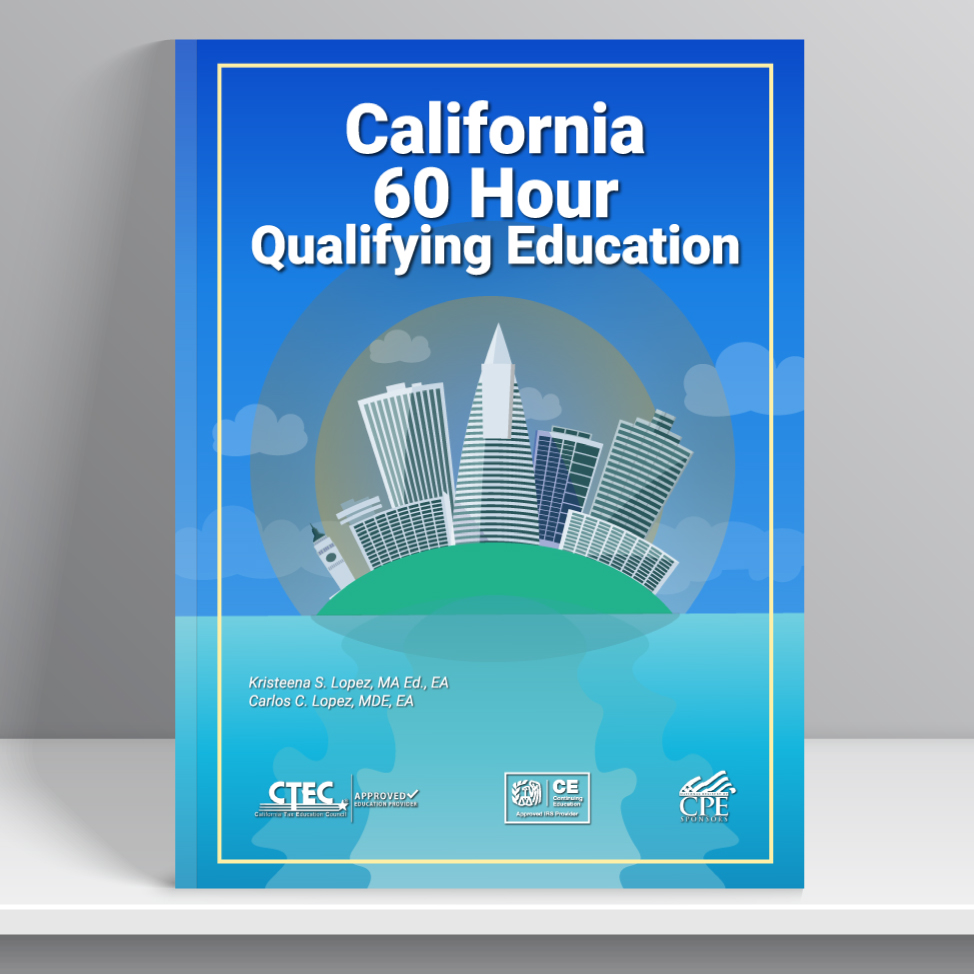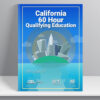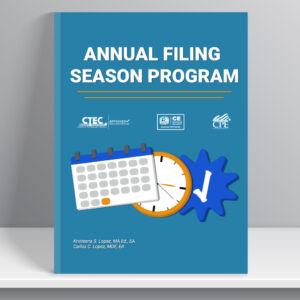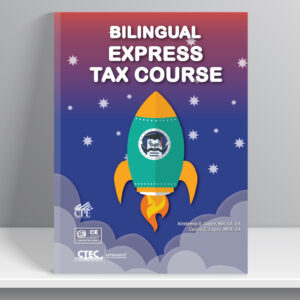Chapter 1: Ethics
This chapter will explain how to determine who qualifies as a tax return preparer, what representation rights a preparer has, how that individual is bound by the Circular 230 guidelines, and what it means for a tax preparer to behave ethically and responsibly.
Chapter 2: Best Practices to Counteract Cybercrime
Protecting yourself and your clients is one of the biggest challenges that tax return preparers face today. Criminals have learned that tax return preparers have a lot of information about their customers, including their Social Security numbers, information about their families, and employment history. Criminals want to steal this information and weaponize it to steal money from banks, the IRS, or conduct other crimes.
Chapter 3: Compiling Taxpayers Information
This chapter explains the importance of interviewing the taxpayer. Each segment of the chapter will cover a section of Form 1040 with sample interview questions that are needed for the section discussed. The tax professional needs to understand the importance of knowledgeable questions to determine if the taxpayer is eligible to claim certain credits. Interview questions asked should be documented as well as the answers the taxpayer provided. Knowing basic tax law is essential.
Preparing tax returns is an art; knowing which questions to ask will help determine the best tax situation for the individual. Just imputing information into software does not prepare an accurate tax return. The saying is true: “garbage in, garbage out”. Entering incorrect information so that the taxpayer receives a higher refund is not the best situation for you or the client. This chapter provides you with a brief overview of current year forms and sample questions to determine the best tax position for the taxpayer. Asking the taxpayer, the right questions from the beginning provides the tax preparer accurate answers needed to complete the tax return.
CA Compiling Taxpayers Information
The California tax return does not follow the federal return line-by-line, as established by the following:
- California subtracts the exemption amount from the tax owed.
- California did not conform to the TCJA with respect to not being able to claim an exemption for dependents.
- California begins by gathering the taxpayer’s and spouse’s personal information.
- If the couple’s status is a registered domestic partner (RDP) or same-sex married couple (SSMC), you will enter the spouse’s information on Form 540.
The information needed to complete the state return is:
- First and last name as found on SSN or ITIN.
- Address (including city, state, and zip).
- Date of birth.
- Prior name (if the taxpayer or spouse filed a prior California return with a different last name).
California does not conform to most of the federal Tax Cuts and Jobs Act changes. A tax practitioner needs to understand state tax law to make sure that the taxpayer is receiving all the credits and paying the correct amount of tax.
Chapter 4: Filing Status, Dependents, and Deductions
This chapter will present an overview of the Tax Cuts and Jobs Act standard deduction and what circumstances permit taxpayers to claim a higher standard deduction. You will also learn what an exemption is, what exemptions each of the filing statuses can claim, and how to identify a qualifying dependent.
CA Standard Deductions, Dependents, and Filing Status
California did not conform to most of the federal Tax Cuts and Jobs Act changes. Subsequently, as a California tax preparer, you will need to make sure your software allows for the personal exemptions as required to complete the California state return.
As you have already seen, filing statuses can get very complicated at the Federal level. Unfortunately, it gets even more complicated when you include filing statuses at the state level as well. As previously stated, state law governs many aspects of the filing, like whether a taxpayer is married or legally separated under a divorce or separate maintenance decree. It is important for California tax preparers to know their state’s laws to prepare their clients’ returns as accurately and professionally as possible.
Chapter 5: Income
The IRS has the authority to tax all income from whatever source it is derived. This includes compensation for services, gains from dispositions of property, interest and dividends, rent and royalties, pensions and annuities, gambling winnings, and even illegal activities. All such income a person receives is collectively referred to as “worldwide income.” However, not all money or property is taxable or subject to tax. This chapter will cover the different types of taxable and nontaxable income and show you where and how to report such wages on a professionally prepared tax return. A tax professional must recognize the different kinds of taxable income, tax-exempt income, and other income included in Schedule 1, line 21, and must know how to figure out the taxable percentage on Social Security benefits.
CA Income
Although California does not conform to certain provisions of the Internal Revenue Code, it does conform in the following ways:
- The “general rule.”
- The “simplified general rule,” or the “safe harbor method.”
- IRA rollovers.
- Roth IRAs.
- Archer MSAs.
- Coverdell ESAs.
- Current-year IRA deductions.
- Lump-sum credits received by federal employees.
Chapter 6: Interest and Dividends
Any interest or dividends can be taxable income if they are credited to the taxpayer’s account and can be withdrawn. This chapter will cover the exceptions to this rule and show which interest and dividends are not taxable income and which expenses can be deducted on the taxpayer’s Schedule A if the taxpayer itemizes.
CA Interest and Dividends
Most interest income taxable by federal standards is also taxable by the state of California. There are a few exceptions, however, including the fact that California exempts interest income for U.S. obligations. In California, adjustments are not made for exempt-interest dividends. Certain mutual funds are qualified to pay an exempt-interest dividend if at least 50% of their assets consist of tax-exempt government obligations. The portion of the exempt-interest dividend should be shown on the annual statement from the mutual fund. If the California exempt-interest dividend amount is different from the federal amount, an adjustment will be required.
Chapter 7: Tax Credits and Payments
A nonrefundable tax credit reduces the amount of tax liability that may have to be paid. Unlike a deduction, which reduces the amount of income that is subject to taxation, a credit directly reduces the tax itself. There are two types of credits: nonrefundable, which cannot reduce tax liability below zero, and refundable, which can reduce tax liability below zero, resulting in the need for a refund.
CA Tax Credits and Payments
Although a variety of California tax credits are available to help the taxpayer reduce their tax liability, California does not conform to all the credits that can be claimed on the federal return. This chapter will cover FTB Form 540, lines 40-48. California refers to this section as “Special Credits”. A tax preparer is responsible for ensuring (to the best of his or her knowledge) that the taxpayer is filing a true and accurate return by asking the client detailed questions and doing as much research as necessary.
Chapter 8: Adjustments to Income
In this chapter, students will learn how various expenses are used to “adjust” or lower the taxpayer’s income to arrive at his or her adjusted gross income (AGI). They will also learn how the Tax Cuts and Jobs Act (TCJA) has impacted adjustments at the federal level and how to handle any previous-year returns that preceded those TCJA-mandated changes.
CA Adjustments to Income
In this chapter, you will learn what adjustments need to be made to California income and where to enter it on 540 Schedule CA. You will first review a few items from Part I, Section A, Income. Then, you will review Part I, section B, Adjustments to Income. The chapter will conclude by presenting a few items from Part II, Adjustments to Federal Itemized Deductions.
Chapter 9: Itemized Deductions
When computing taxable income, personal expenses cannot be claimed as itemized deductions; however, tax rules do allow for some deductions that are essential for daily living. These specific expenses are deductible as itemized deductions. A standard deduction is a set amount that the taxpayer can claim based on his or her filing status. Itemized deductions are shown on the tax return using Schedule A, Itemized Deductions. The taxpayer must decide whether to itemize deductions or use the standard deduction and should choose whichever option is best for their tax situation.
CA Itemized Deductions
The Tax Cuts and Jobs Act made some changes to the Internal Revenue Code (IRC) that California did not adopt. California does conform with IRC regulations established on and before January 1, 2015. Because of these changes, California residents will need to make adjustments on their 540 Schedule CA to account for the differences between state and federal tax law.
Chapter 10: Other Taxes and Taxpayer Penalties
This chapter provides an overview of miscellaneous taxes from Form 1040 and reported on Schedule 2 that a taxpayer might be assessed. This includes excess Social Security tax, additional taxes on IRAs, the Alternative Minimum Tax, and household employment taxes.
CA Other Taxes and Taxpayer Penalties
The Franchise Tax Board (FTB) is the agency responsible for collecting state personal income taxes in California. The revenues FTB collects are placed in the state’s general fund to help pay for items, such as roads, parks, law enforcement, and schools. California’s state income tax system is based on the principle of voluntary compliance. Voluntary compliance is a system of taxation that relies on individual citizens to properly report their income, calculate their tax liability, and file their tax returns timely.
This lesson is a brief overview of other California taxes that a taxpayer might pay as well as the types of penalties a taxpayer may pay and why.
Chapter 11: Capital Gains and Losses
Almost everything a taxpayer owns and uses for personal or investment purposes is a capital asset. When a capital asset is sold, the difference between the basis in the asset and the amount the item is sold for is either a capital gain or a capital loss. A capital gain is the profit that results from selling an investment (stocks, bonds, or real estate) for a higher price than it was purchased. Capital gains may refer to investment income that arises in relation to real assets (such as property), financial assets (such as shares of stocks or bonds), and intangible assets (such as goodwill). A capital loss arises if the proceeds from the sale of a capital asset are less than the purchase price. The taxpayer can deduct up to a $3,000 loss ($1,500 if filing MFS). The capital loss that exceeds the limit amount may be taken in future years.
CA Capital Gains and Losses
California law complies with federal law regarding capital gains and losses and requires no adjustments to complete the state return. If the California basis of the taxpayer’s assets differs from the federal, adjustments would be required using the California Schedule D. The capital gains tax rates are the same for both California and federal law. The amount of capital loss limitation for California taxpayers is also the same as the federal limitation.
Chapter 12: Business Income
This chapter presents an overview of Schedule C, which includes income and expenses. The income or loss is reported on Form 1040, Schedule 1, line 3. Sole proprietorship is not a legal entity; it refers to a person who owns a business and is personally responsible for its debts. Sole proprietorship is a popular business structure due to the simplicity, ease of setup, and nominal startup costs. Ultimately, a sole proprietor would register the business name with the state and city, obtain local business licenses, and then open for business. A drawback of being a sole proprietor is that the owner is 100% personally liable for the business’s income and/or debt.
CA Business Income
This chapter will present the differences between the way federal tax law treats business income and the way California tax law treats it. This includes self-employment income, rental income, self-employment tax, withholding issues for self-employed nonresidents, common law employees, statutory employees, and contractors.
Chapter 13: Depreciation
Depreciation is an annual deduction that allows taxpayers to recover the cost or other basis of their business or investment property over a certain number of years. Depreciation is an allowance for the wear and tear, decline, or uselessness of a property and begins when a taxpayer places property in service for use in a trade or business. The property ceases to be depreciable when the taxpayer has fully recovered the property’s cost or other basis or when the property has been retired from service, whichever comes first. Depreciation is reported on Form 4562.
CA Depreciation
California law has not always conformed to federal law regarding depreciation methods, special credits, or accelerated write-offs. In general, California law conforms to the Internal Revenue Code as of January 1, 2015; however, recovery periods and basis on which depreciation is calculated may be different from the amounts used for federal purposes. Reportable differences occur if the asset was placed in service at the following times:
- Before January 1, 1987: California disallowed depreciation under the federal Accelerated Cost Recovery System (ACRS). Continue to calculate California depreciation in the same manner as in prior years for those assets.
- On or after January 1, 1987: California provides special credits and accelerated write-offs that affect the California basis for qualifying assets. California does not conform to all the changes to federal law enacted in 1993. Therefore, the California basis or recovery period may be different for some assets.
For more information regarding California and federal law that will be provided here, visit the FTB website and search for the term “conformity”.
Chapter 14: Electronic Filing
Electronic filing (also referred to as E-File and E-filing) is the process of submitting tax returns over the internet via properly-certified tax software. The E-File system has made tax preparation significantly easier, and the IRS notifies software users within 24-48 hours if they accepted or rejected the tax return. E-filing is not available year-round but rather begins sometime in January and ends sometime in October; the IRS determines when exactly e-filing begins and ends each year, and states follow whatever dates the IRS sets. An electronic return originator (ERO) is the individual who originates the electronic submission of the tax return. To file a return electronically, the individual needs to be an Authorized IRS e-File Provider.
CA Electronic Filing
California conforms to the federal guidelines regarding electronic filing and the importance of safeguarding the taxpayer’s personal identification information. However, California has systems in place to perform these duties at the state level, and it is important for California tax professionals to know them and how they are different. For more information, see California Revenue & Taxation Code Sections 18621.9 and 19170.
Chapter 15: Extensions and Amendments
If taxpayers are unable to file their federal individual tax returns by the due date, he or she may be able to qualify for an automatic six-month extension of time to file. The taxpayer can either electronically file or mail Form 4868 to the IRS to file for the extension. If the taxpayer has filed a return and realizes that a mistake was made, he or she would file an amended return by using Form 1040-X.
CA Extensions and Amendments
If taxpayers are unable to file their California individual tax return by the due date, they may be able to qualify for an automatic six-month extension of time to file by electronically filing or mailing Form 3519 to the FTB. If the taxpayer has filed a return and realizes that a mistake was made, he or she would have to file an amended return using Schedule X.
| Course Details | Included in this course |
| Title: 2023 Bilingual CTEC 60 Hour Qualifying Education Level: Beginner Delivery Method: Self-study CTEC Vendor: #2080 CTEC Course: 2080-QE-001To earn a certificate of completion:• Pass Quizzes with 70% (or higher) • Pass Each Final with 70% (or higher) • Complete Course Survey |
• 15 Chapters (eBook) • Quizzes • Videos • Practice Tax Return • Practice Tax Return Final • Finals (3) » Ethics » Federal Tax Law » California Tax Law |
| All CTEC Registered Tax Preparers (CRTP) must… |
| • First complete 60-hours (45 hours federal and 15 hours state) of qualifying tax education from a CTEC Approved Provider
• Obtain a PTIN (Preparer Tax Identification Number) from the IRS • Purchase a $5,000 tax preparer bond • Register with CTEC within 18 months from the completion date on the certificate of completion • Registration Fee with CTEC $33 |
This course has been approved by the California Tax Education Council (2080-QE-001), which fulfills the 60-hour qualifying education requirement imposed by the state of California to become a tax preparer. A listing of additional requirements to register as a tax preparer may be obtained by contacting CTEC at P.O. Box 2890, Sacramento, CA, 95812-2890 or 1-877-850-2832 or www.CTEC.org.






